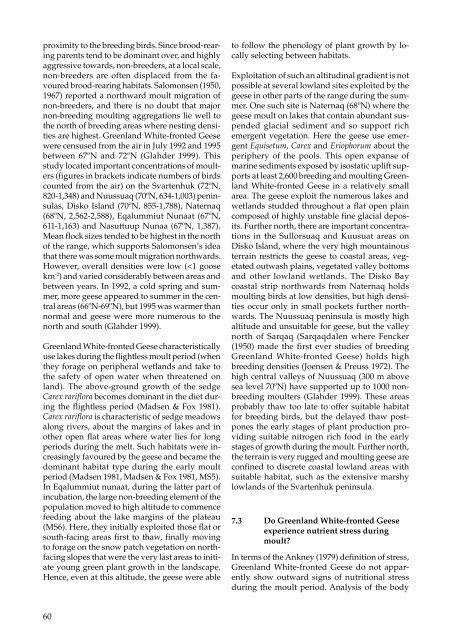The Greenland White-fronted Goose Anser albifrons flavirostris
The Greenland White-fronted Goose Anser albifrons flavirostris
The Greenland White-fronted Goose Anser albifrons flavirostris
You also want an ePaper? Increase the reach of your titles
YUMPU automatically turns print PDFs into web optimized ePapers that Google loves.
proximity to the breeding birds. Since brood-rearing<br />
parents tend to be dominant over, and highly<br />
aggressive towards, non-breeders, at a local scale,<br />
non-breeders are often displaced from the favoured<br />
brood-rearing habitats. Salomonsen (1950,<br />
1967) reported a northward moult migration of<br />
non-breeders, and there is no doubt that major<br />
non-breeding moulting aggregations lie well to<br />
the north of breeding areas where nesting densities<br />
are highest. <strong>Greenland</strong> <strong>White</strong>-<strong>fronted</strong> Geese<br />
were censused from the air in July 1992 and 1995<br />
between 67ºN and 72ºN (Glahder 1999). This<br />
study located important concentrations of moulters<br />
(figures in brackets indicate numbers of birds<br />
counted from the air) on the Svartenhuk (72ºN,<br />
820-1,348) and Nuussuaq (70ºN, 634-1,003) peninsulas,<br />
Disko Island (70ºN, 855-1,788), Naternaq<br />
(68ºN, 2,562-2,588), Eqalummiut Nunaat (67ºN,<br />
611-1,163) and Nasuttuup Nunaa (67ºN, 1,387).<br />
Mean flock sizes tended to be highest in the north<br />
of the range, which supports Salomonsen’s idea<br />
that there was some moult migration northwards.<br />
However, overall densities were low (


